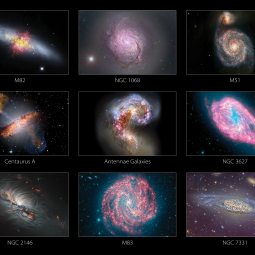By Enrique Lopez-Rodriguez and Joan Schmelz
Paper:
Extragalactic magnetism with SOFIA (SALSA Legacy Program) -- IV: Program overview and first results on the polarization fraction
Lopez-Rodriguez, Enrique, et al., 2022-05-00.
The evolution of galaxies is controlled by a delicate interplay between gravity, turbulence, feedback, dark matter, and magnetic fields. Most current empirical and theoretical approaches to understanding this interplay focus on all these factors – except magnetic fields. Magnetic fields are also needed to explain astrophysical phenomena such as star formation across cosmic time, accretion onto super massive black holes, and even planet formation. Thus, a self-consistent description of the interplay between the multi-phase interstellar medium and magnetic fields is needed to make progress on the fundamental processes controlling galactic evolution.
The SOFIA legacy program nicknamed SALSA aims to construct a comprehensive empirical picture of the magnetic field structure in the multi-phase interstellar medium of nearby galaxies. One of the main goals is to study the effect of the gas dynamics on the magnetic fields from hundred-pc-to-kpc scales in different types of galaxies.
The first data release of SALSA comprises multi-wavelength polarimetric observations from HAWC+ of 14 nearby galaxies. These results are shaping, refining, and revolutionizing our understanding of extragalactic magnetism. Unquestionably, SALSA has shown that the magnetic fields are always present in the cold, dense interstellar medium of all galaxies.
SOFIA has discovered that:
- the magnetic field morphology is not necessarily the same in the diffuse and dense interstellar medium across the galactic disks of spiral galaxies like M51 and NGC 1068 ;
- the magnetic field following a warped molecular disk in the remnant of a merger galaxy like Centaurus A is being amplified and highly turbulent;
- the galactic magnetic field can be dragged away permeating the intergalactic medium via galactic winds like those in the starburst galaxy M82 ; and
- a magnetically-driven flow feeds the super massive black hole of the active nucleus in NGC 1097 .
The new release presents a statistical analysis of galaxies as a function of wavelength, inclination, and galaxy type. Using the dependency of the state of polarization and the physical properties of the interstellar medium in spiral galaxies, this work is able to identify the ordered magnetic field associated with shear or compression along the spiral arms and the random magnetic field associated with star formation regions across the galaxy disks. These results allow us to understand the mechanisms responsible for the amplification and generation of magnetic fields in galaxy evolution.
Although magnetic fields are found in all galaxies, there is not yet a comprehensive theory about how the present-day galactic magnetic fields originate. The results presented in this release can be used to understand how magnetic fields permeate the intergalactic medium at early stages of the universe, investigate the processes of star formation and the assembly of giant molecular clouds in galaxies, and refine dynamo theories responsible for galaxy formation.
The current combination of the magnetic fields in the cold, dense regions via far-infrared polarimetric observations and warm, diffuse regions via radio polarimetric observations provide the ground truth to refine theoretical models. Future far-infrared polarimetric space missions will be required to perform a complete census of magnetic fields in galaxy evolution.
